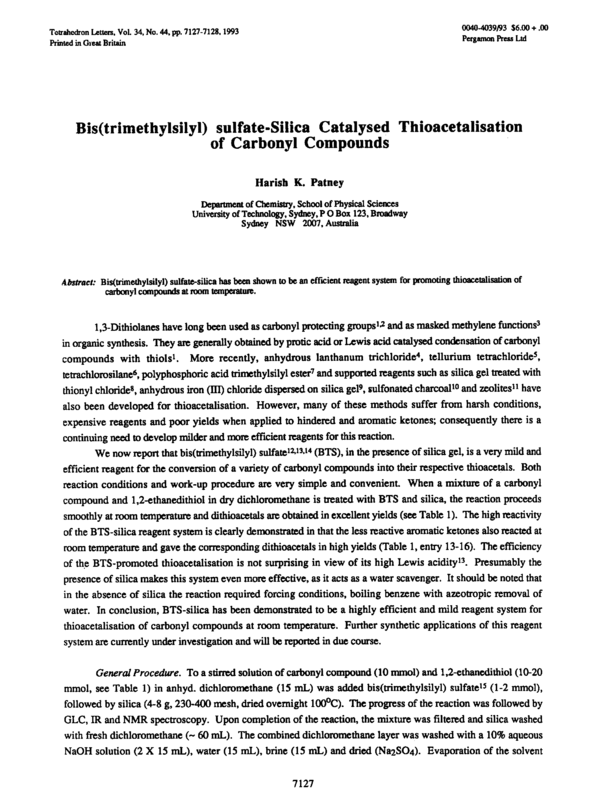Bis(trimethylsilyl) Sulfate-Silica Catalysed Thioacetalisation of Carbonyl Compounds
Bis(trimethylsilyl) Sulfate-Silica Catalysed Thioacetalisation of Carbonyl Compounds
Journal:
Year:
Abstract:
Bis(trimethylsilyl) sulfate-silica has been shown to be an efficient reagent system for promoting thioacetalisation of carbonyl compounds at room temperature.
DOI:
10.1016/S0040-4039(00)61616-7
Type of document:
Language:
0040-4039193$6.00 + .OO
PergamcnPress Ltd
Tetrahedron
Letters.Vol. 34. No. 44. Pp. 7127-7128.1993
Printedin Gut Britain
Bis(trimethylsily1)
sulfate-Silica
Catalysed
of Carbonyl Compounds
Thioacetalisation
Harish K. Patney
Departmwu Chemistry. School of F’bysicd Sciences
of
Universityof Technology. Sydney, P 0 Box 123, Broadway
Sydney
Abstract:
NSW
2007.Attsunlii
Bis@imethylsilyl) sulfatesilica has beat shown to be an effdrtt
carbonyl canpounds at mom lemperatme.
reagent system for promoting thioacetalisatiott of
1,3-Dithiolanes have long been used as carbonyl protecting gtoupsQ and as masked methylene functions3
in organic synthesis. They am generally obtained by protic acid or Lewis acid catalysed condensation of carbonyl
More recently, anhydrous lanthanum trichloride4. tellurium tetrachlorides,
compounds with thiolst.
tetrachlorosilane6, polyphosphoric acid trimethylsilyl ester’ and supported reagents such as silica gel treated with
thionyl chlorides, anhydrous iron (III) chloride dispersed on silica gels, sulfonated charcoalto and zeolitestt have
also been developed for thioacetalisation.
However, many of these methods suffer from harsh conditions,
expensive reagents and poor yields when applied to hindered and aromatic ketones; consequently there is a
continuing need to develop milder and mom efficient reagents for this reaction.
(BTS), in the presence of silica gel, is a very mild and
We now report that bis(trimethylsily1) sulfate 1 13.14
2
efficient reagent for the conversion of a variety of carbonyl compounds into their respective thioacetals. Both
reaction conditions and work-up procedure are very simple and convenient.
When a mixture of a carbonyl
compound and 1,2-ethanedithiol in dry dichloromethane is treated with BTS and silica, the reaction proceeds
smoothly at room temperahue and dithioacetals are obtained in excellent yields (see Table 1). The high reactivity
of the BTS-silica reagent system is clearly demonstrated in that the less reactive aromatic ketones also reacted at
room temperature and gave the corresponding dithioacetals in high yields (Table 1, entry 13- 16). The efficiency
of the BTS-promoted thioacetalisation is not surprising in view of its high Lewis acidityIs. Presumably the
presence of silica makes this system even more effective, as it acts as a water scavenger. It should be noted that
in the absence of silica the reaction required forcing conditions, boiling benzene with azeotropic removal of
water. In conclusion, BTS-silica has been demonstrated to be a highly efficient and mild reagent system for
thioacetalisation of carbonyl compounds at room temperature. Further synthetic applications of this reagent
system are currently under investigation and will be mported in due course.
General Procedwe. To a stirred solution of carbonyl compound (10 mmol) and 1,2-ethanedithiol (lO-20
mmol, see Table 1) in anhyd. dichloromethane (15 mL) was added bis(trimethylsily1) sulfate’s (l-2 mmol),
followed by silica (4-8 g, 230400 mesh, dried overnight 100eC). The progress of the reaction was followed by
GLC, IR and NMR spectroscopy. Upon completion of the reaction, the mixture was filtered and silica washed
with fresh dichloromethane (- 60 mL). The combined dichloromethane layer was washed with a 10% aqueous
NaOH solution (2 X 15 mL), water (15 mL), brine (15 mL) and dried (NazS04).
7127
Evaporation of the solvent
7128
under mduced pressure gave the crude product which was purified by chromatography over neutral alumina.
Table 1.
Tbioacetalisation
Entry
of Carbonyl Compounds
Substrate
using BTS/Silica
BTS
(mmol)
1
1
2
Reagent
1,3-Dithiolanes1.b
Reaction
Yield (%)
time
95
15 min
-Ydc
Benzaldehyde
1
97
15 mill
3
1
97
15 mill
4
p-Nitmbenzaldehyde
1
89
3Omin
5
Cinnamaldehyde
1
90
15 mill
6
Cyclohexanone
1
93
30min
7
2Methylcyclohexanone
1
96
lh
8
2-Adamantanone
2-Hexanone
1
92
2h
9
1
98
1 hc
10
Cyclopentanone
2
99
lh
11
3Pentanone
2
95
3h
12
2-Gctanone
2
97
3h
13
Acetophenone
2
96
8 h“
14
9-Fluorenone
2
1.3~Diphenyl-2-propanone
2
95
94
5 h=C
15
16
Benzophenone
2
94
2 dayscd
17
Camphor
2
750
2 day&
8 hd
a) Yield of isolatedproductcltarachsed by physicaland spectral
data; b) PurityL 98%by GLC: c) 20 mm01of 1.2-ethanedithiol
used; d) 8 g of silica gel used; e) 75%convmion by GLC.
AckttowZedgntent.The author wishes to thank Mr B. McQuillan for the GLC work and MS L. Ambrose for
the technical assistance.
References and Notes
’
1.
Greene, T.W.; Wuts, P.G.M. Protective Groups in Organic Synthesis;John Wiley: New York. 2nd Ed.
1991; pp. 201-207.
2. Loewanthal, H.J.E. Protective Groups in Organic Chemist ; McGmie, J.F.W. Ed., Plenum, New York.
1973:, vu. 323402.
Pettit, G.R.; van Tamelen, E.E. Org. Reactions 1962.12.356-529.
:: Garlaschelli, L.; Vidari, G. TetrahedronLett. 1990,31,5815-5816.
Tani, H.; Masumoto, K.; Inamasu, T. TetrahedronLett. 1991,32,2039-2042.
:: Ku, B.; Oh, D.Y. Synth. Commun. 1989, 19,433-438.
Kakimoto, M.; Seri, T.; Imai, Y. Synthesis 1987,164-166.
:* Kamitori, Y.; Hojo, M; Masuda, R.; Kimura, T.; Yoshida, T. J. Org. Chem. 1986.51,1427-1431.
9: Patney, H.K. Tetrahedron Lett. 1991,32,2259-2260.
32,413-416.
10. Patney, H.K. Tetrahedron L.ett. 1991,
33,
11. a) Kumar, P.; Reddy, R.S.; Singh, A.P.; Pan&y, B. Tetrahedron Lett. 1992, 825-826.
b) Kumar, P.; Reddy, R.S.; Singh, A.P.; Pandey, B. Synthesis 1993,67-69.
12. This reagent has been shown to be very effective in the rearrangement of vinylcycloptopanecarboxylic esters
into ~butyrolactones (ref 13) and tetrahydropyranylation of alcohols (mf 14).
57,
13. a) Morizawa, Y.; Hiyama, T.; Oshima, K.; Nozaki, H. Bull. Chern. Sot. Jpn. 1984, 1123-1127.
b) Morizawa. Y.; Hiyama, T.; Oshima, K.; Nozaki. H. Tetrahedron Lett. 1981,22,2297-2300.
Morizawa, Y.; Mori, I.; Hiyama, T.; Nozaki, H. Synthesis 1981,
899-901.
ii: Duffaut, N.; Calas, R.; DunoguCs. J. Bull. Sot. Chim. Fr. 1963,512-517.
I.
(Received in UK 4 August 1993; accepted 3 September 1993)
Coments go here:
- Log in to post comments

